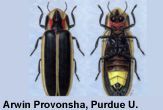Firefly Juice Lights Up Mouse Bellies

The magic of fireflies is more than just a child's delight. Researchers have inserted the insect's light-shining compound into proteins, allowing them to non-invasively track biological mechanisms in living tissue.
Fireflies have a protein called luciferase that allows them to send light signals to each other. David Piwnica-Worms from Washington University and his colleagues carefully cut luciferase in half and incorporated both pieces into separate proteins, which only interact in the presence of an antibiotic called rapamycin. By design, light is emitted from the luciferase pieces only when the target proteins are able to unite.
The team placed cells, engineered to produce these altered proteins, into the bellies of mice. They observed a glow through the skin of those animals that had been administered rapamycin.
The light from the protein combinations was not visible to the naked eye because most of the photons were absorbed in the intervening tissue. But with a sensitive digital camera, the researchers were able to detect a signal that was 10,000 times stronger than the background light.
"This technique opens another window to look at these protein interactions," Piwnica-Worms said.
A report on this technique was published in the Proceedings of the National Academy of Sciences.
The way that proteins pair up has garnered increased interest since the discovery that the human genome has fewer genes than expected. "The corollary of this finding is that proteins must have multiple functions," Piwnica-Worms remarked.
Sign up for the Live Science daily newsletter now
Get the world’s most fascinating discoveries delivered straight to your inbox.
To understand this multi-tasking, scientists want to see proteins at work in a living organism, as opposed to a test tube or a cell culture. This sort of noninvasive imaging may be a boon to pre-clinical studies of anti-cancer drugs that block protein interactions in tumor cells.
But for those hoping to one day impress their friends by glowing in the dark, Piwnica-Worms said that human testing is probably in the way distant future.













